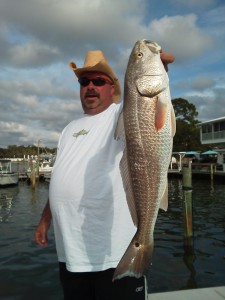As the Fall fishing season progresses, more anglers are back on the flats with the slight coolness that has filled the air. Often times finding a personal little fishing hole off the beaten path can be rewarding. This time of year is great for finding such spots as the fish are moving into transitional areas and can be found in a variety of different places. Artificials will cover more ground and allow anglers to seek snook, redfish and other inshore species that will be layed up in potholes and depressions along the grassflats. Moving water and some type of structure is the key to producing a good fishing spot that will hold gamefish throughout these next two months.
When searching for new fishing holes, it is best to have the boat prepared so that each situation can be thoroughly fished. Having an anchor tied off a stern cleat and ready to deploy once fish are spotted allows unnecessary chaos if a school of fish is found ahead during a drift. The Power Pole is a shallow water hydraulic anchor that works by remote and serves the same purpose as it is deployed silently. By stopping the boat, anglers are able to fan cast an area and cover all possible depths and potholes that will hold fish. Another great tool is a trolling motor that allows a silent approach into shallow areas without pushing the fish out with engine noise. By running the electric motor on low, most trout and redfish will not race off, but merely move a cast away and still give anglers another shot at them. These two accessories are the most important tools on the boat that will be used in finding new fishing grounds.
 The use of artificials in finding inshore gamefish works well in the Fall as most fish will start to change their diets towards crustaceans and other cold water baits. A great search tool in finding redfish and snook is a single-hook, weedless spoon with a bucktail trailer. Copper with a brown trailer works best where there are mangroves and tea-stained water and silver with a white trailer works well in clear water situations where there is a lot of small sardines. The action of a weedless spoon gives anglers the advantage of working through grass and other debris and still fish all levels of the water column.
The use of artificials in finding inshore gamefish works well in the Fall as most fish will start to change their diets towards crustaceans and other cold water baits. A great search tool in finding redfish and snook is a single-hook, weedless spoon with a bucktail trailer. Copper with a brown trailer works best where there are mangroves and tea-stained water and silver with a white trailer works well in clear water situations where there is a lot of small sardines. The action of a weedless spoon gives anglers the advantage of working through grass and other debris and still fish all levels of the water column.
Soft jerkbaits in turtlgrass or motor-oil color are also working well when rigged with an 1/8 ounce weedless jighead. The erratic motion of these baits will often draw a reaction strike from nearby predators as it swims back to the boat. The darker colors work best this time of year, as it blends in with the bottom and helps to disguise the presentation.
Most snook have moved away from the beaches and are beginning the track towards their winter homes. When this first happens, the bite for these linesiders can slow dramatically compared to the summer bite that anglers are used to. Some extra time must be spent looking for them this time of year. Once located, the best thing to do is take note of where and how they are staged up with the structure that is being used. This becomes a great indicator of where other snook will be found over the next month. With the gin clear waters off St. Joseph Sound, downsizing leader is a must in order to get most snook to eat. Twenty-five fluorocarbon leader with 2/0 hooks have worked best, as long as the reel’s drag is not too tight to create excess friction and break the line. Freelining greenbacks has worked well and lets the baits swim naturally through a given strike zone without the restriction of a cork. Medium baits have outproduced the larger ones, as it is an easier meal to chase down.
 With a steady increase of schools of redfish from Clearwater all the way up to the Hudson area, incoming tides will push these fish upon to a shallow flat and feed aggressively on crabs and small pinfish. A tail-hooked shrimp will allow anglers to cast way ahead of a school without scaring them. This low profile bait works well because it will crawl along the bottom where the reds are searching. These bronze bruisers will get into such as bottom-feeding mode that often times a live bait swimming towards the top of the water column will go untouched.
With a steady increase of schools of redfish from Clearwater all the way up to the Hudson area, incoming tides will push these fish upon to a shallow flat and feed aggressively on crabs and small pinfish. A tail-hooked shrimp will allow anglers to cast way ahead of a school without scaring them. This low profile bait works well because it will crawl along the bottom where the reds are searching. These bronze bruisers will get into such as bottom-feeding mode that often times a live bait swimming towards the top of the water column will go untouched.














